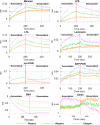A Versatile Hemolin With Pattern Recognitional Contributions to the Humoral Immune Responses of the Chinese Oak Silkworm Antheraea pernyi
- PMID: 35669768
- PMCID: PMC9163686
- DOI: 10.3389/fimmu.2022.904862
A Versatile Hemolin With Pattern Recognitional Contributions to the Humoral Immune Responses of the Chinese Oak Silkworm Antheraea pernyi
Abstract
Hemolin is a distinctive immunoglobulin superfamily member involved in invertebrate immune events. Although it is believed that hemolin regulates hemocyte phagocytosis and microbial agglutination in insects, little is known about its contribution to the humoral immune system. In the present study, we focused on hemolin in Antheraea pernyi (Ap-hemolin) by studying its pattern recognition property and humoral immune functions. Tissue distribution analysis demonstrated the mRNA level of Ap-hemolin was extremely immune-inducible in different tissues. The results of western blotting and biolayer interferometry showed recombinant Ap-hemolin bound to various microbes and pathogen-associated molecular patterns. In further immune functional studies, it was detected that knockdown of hemolin regulated the expression level of antimicrobial peptide genes and decreased prophenoloxidase activation in the A. pernyi hemolymph stimulated by microbial invaders. Together, these data suggest that hemolin is a multifunctional pattern recognition receptor that plays critical roles in the humoral immune responses of A. pernyi.
Keywords: antimicrobial peptide synthesis; hemolin; humoral immunity; pattern recognition receptor; prophenoloxidase activating system.
Copyright © 2022 He, Zhou, Cai, Liu, Zhao, Zhang, Wang and Zhang.
Conflict of interest statement
Author YL is employed by Liaoning Applos Biotechnology Co. Ltd. The remaining authors declare that the research was conducted in the absence of any commercial or financial relationships that could be construed as a potential conflict of interest.
Figures







References
Publication types
MeSH terms
Substances
LinkOut - more resources
Full Text Sources

